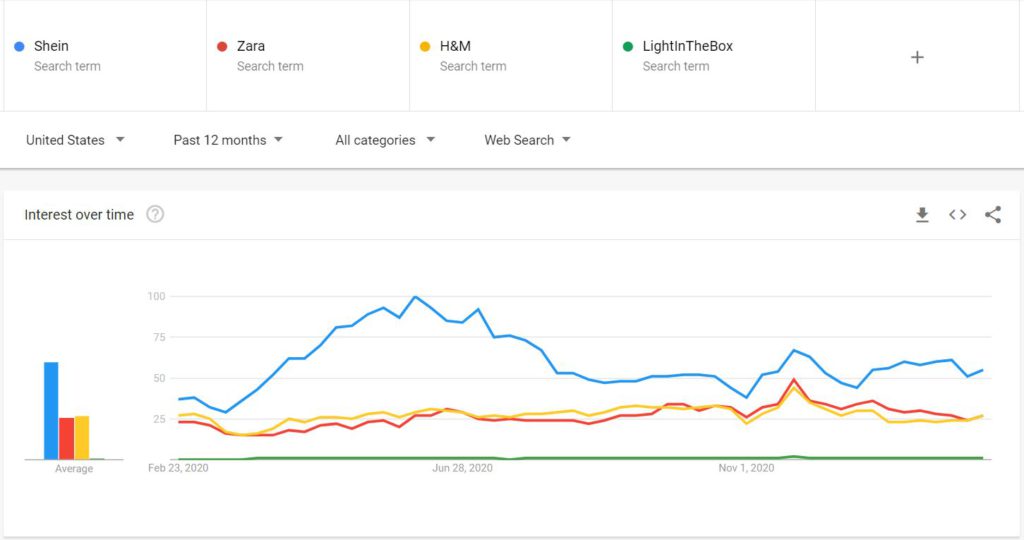In July 2020, Google and public relations firm WPP published its BrandZ list, identifying the top 50 Chinese brand builders that were going global. The roster included a slew of well-known names, such as tech giants Huawei and Xiaomi, with their extensive overseas operations, as well as older state-owned enterprises such as Bank of China. Sandwiched between Oppo and DJI on this list, in the 13th slot, was a name less recognized—a company called Shein.
What is Shein? And why was it on this list? This is a mystery to many people even in China. Compared to most firms that found success at home before heading overseas, Shein catered to the tastes of clients abroad, rendering it relatively unknown in China, the largest consumer market in the world.
Shein is an online fashion retailer that specializes in cheap, fast fashion. As of 2020, Shein’s distribution network covers over 220 countries and territories worldwide. With COVID-19 trapping many at home, online shopping has been a source of therapy and entertainment. Shein’s sales skyrocketed. In H1 2020, its sales revenue was over RMB 40 billion (USD 6.1 billion), nearly on par with Uniqlo, and already three times that of Levi’s and double of Victoria’s Secret. This is in contrast with fashion retail giants like Zara shuttering stores around the world and Forever 21 filing for bankruptcy. Against this backdrop, Shein has gone one step further with rumors of the company bidding to take over ownership of TopShop.
Master of marketing
There were 17.5 million downloads of shopping apps globally in May 2020, surpassing the previous peak of 12 million in May 2019, according to data compiled by Sensor Tower. Fashion needs e-commerce, and several big players in the fashion industry are attempting to build their own online shopping platforms. But Shein started early. The company originally had aspirations to become like LightInTheBox.com, one of the first cross-border e-commerce platforms headquartered in China, according to a Huge.com report published in 2014. Seven years ago, around 40% of its traffic came from search results, with paid clicks amounting to as much as 73% of its hits. Now, however, Shein’s traffic from organic searches stands head and shoulders above those of its competitors.

Search engine diversions are addictive. Investing in advertising here can result in increased sales immediately, giving a new webstore a leg up. But as the size of the business increases, ad prices are bumped up as well, making it more expensive to maintain incoming traffic.
When Shein decided to enter the women’s fashion market, the company designed an unconventional route for itself. Instagram had just been acquired by Facebook, and Twitter’s ticker symbol was about to scroll on the New York Stock Exchange. Social media marketing had yet to kick off, but there were early traces of customers casting influence on their own networks of friends. It was still a minor expense to commission influencers who could recommend items to their followers.
As much as 30% of Shein’s traffic was from trendy social network platforms such as Tumblr, Rstyle, and Lookbook, compared to 15% for LightInTheBox. This form of product placement made products sticky and strengthened brand recall, ultimately increasing consumer awareness for Shein.
Shein maintains its social media profiles assiduously. Shein posted an average of 6.7 posts each day on Facebook, according to data from OneSight, surpassing the frequency of some media outlets. Assisted by paid traffic services, Shein’s average number of impressions for each post exceeded 7,000 with over 100 reposts. In 2020, it hit 20 million followers on Facebook, a mark much higher than cross-border e-commerce rivals from China. Shein also examined opportunities on YouTube. In 2019, the company partnered with Madelaine Petsch, who stars in the drama series Riverdale, making her the face of their Fall 2019 Collection.

Savvy stock selection
How does Shein pick what to sell in countries other than China?
In 2015, someone posed a question on Zhihu, China’s equivalent to Quora, asking for advice on what he could sell in Europe. The response that received the most upvotes suggested that Chinese entrepreneurs should avoid attempting to create demand, and should simply sell items that have a proven track record, but at a lower price. The individual who authored this response was none other than Pei Yang, who was once Shein’s general manager. Indeed, his advice reflects what Shein has been doing for over a decade.
When Shein launched in 2011, it was originally a platform that mainly sold wedding gowns. At the time, LightInTheBox was doing the same for their cross-border e-commerce business. The logic was that individuals would be willing to spend more on wedding dresses, because these are invariably special to every woman who was about to get married. Considering the huge price difference between China and foreign markets, this would offer huge margins to sellers. LightInTheBox sold gowns for an average of USD 200, far cheaper than the average USD 1,000 charged by American retailers. This niche gave LightInTheBox the success it needed to eventually list on the New York Stock Exchange.
Shein wanted to replicate this success, but soon found that this was not sustainable because of low repurchase rates. Most brides hope to only wear a wedding gown once in their life. And Shein was not the only company looking to emulate LightInTheBox. Several other retailers were attempting to elbow their way into the market as well, slashing one another’s profits. In light of this, Shein decided to branch out and carry general women’s apparel.
Fashion is a cutthroat business, with the likes of Zara, H&M, Asos, and TopShop long holding sway over high street consumers. But to Shein, this just demonstrated demand. Shein obtained funding from JAFCO, a Japanese venture capital firm, and acquired its rivals Romwe and Makemechic over the next six years. Along the way, it also snapped up funding from IDG, Sequoia, and Greenwoods. In contrast, LightIntheBox faded in the background and was a hot pick of short sellers by 2013.
Interestingly, Sequoia Capital invested in Perfect Diary, a popular Chinese cosmetics brand that succeeded through savvy branding and marketing, at around the same time it cut checks for Shein’s Series C and D funding rounds. In November 2020, Perfect Diary listed successfully on the New York Stock Exchange. Scarcely a month later, Shein announced that it would also be establishing its private cosmetics label, Sheglam, with cosmetics priced affordably at USD 1–13. True to its style, Shein waited until demand was proven before jumping in, offering products at prices cheaper than almost anywhere else.
Taking a shine to low prices
Compared to Zara, Shein’s prices are ridiculously low. A swimsuit on sale at Zara may have an adjusted price tag of around USD 20, while Shein’s version will cost about USD 13 before markdowns.
One of the first associated Google searches for “Zara dupes” is “Shein.”
Shein’s products are meant to be comparable to Zara’s, with only a small difference in the fabric quality and workmanship. If the unit costs for the two companies’ products are similar, why does Zara set its prices higher than Shein’s? In the fast fashion industry, the most demanding cost is not manpower or material, but inventory management. Fashion brands need to continually produce trendy clothing, but this is done at the expense of older styles, which will then need to be sold at a discount. Reducing inventory is therefore key to sustaining a profit.
To avoid this problem, Shein has purchased stock directly from wholesalers since inception, bringing down its fixed costs. But even this had its limits because the company could not control manufacturers directly.
Shein marries its manufacturing with a strategy of producing small volumes of one product, before placing production orders for greater volumes based on real-time sales demand. To do this, Shein relies heavily on tight relationships with local manufacturers in Guangzhou, developed through years of timely payments, a practice that is unusual for Chinese manufacturers. Because of Shein’s track record, its manufacturers are willing to produce small volumes of goods for Shein. And with strong inventory management capabilities, Shein ensures that only about 10% of its inventory is deemed unsellable, as compared to other fast fashion giants such as H&M, which had about USD 4.3 billion worth of clothing to scrap in 2018.
Shein’s strong relationships with its manufacturers also spills over to its ability to reduce wastage of raw materials. Usually, garment factories need to order fabrics six months in advance, because if they lack stock, they will not be able to produce sufficient clothing should there be a sudden explosion in demand. This means rolls of fabric need to be stockpiled months in advance. But since Shein guarantees a stable supply of orders and payments, its manufacturers are willing to make tweaks to existing stockpiles by tailoring or printing on fabrics, reusing the same material to spin off multiple versions of products to test new lines in case the original designs are not received well by buyers.
Shein’s founders also put their own boots on the ground, personally travelling to different countries to identify logistics partners and services, and to compare customs clearance bureaucracies and warehouse dispersion. It is truly a mammoth task to bring prices down by such a substantial amount. The team behind Shein has poured in an incredible amount of effort to pull all these strings together. They have created the fashion world’s most mysterious brand.
This article was originally published by Caijingyanjiu. It was translated by Lin Lingyi.

